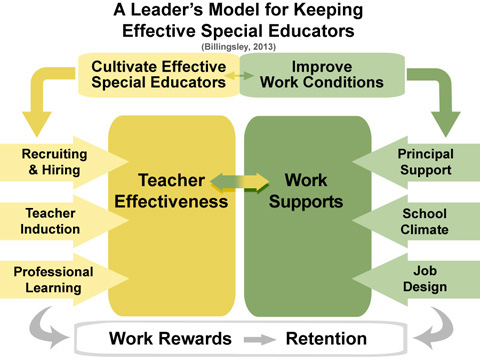Teacher Retention: Reducing the Attrition of Special Educators
Wrap Up
Over the last three decades, there has been a shortage of qualified special education teachers, and administrators have struggled to hire and retain new instructors. Special educators leave their jobs for many different reasons, and often for a combination of them:
- Lack of support from administrators and colleagues
- Large caseloads
- Non-teaching responsibilities (e.g., excessive paperwork)
- Student behavior
- Accountability requirements
- Lack of instructional time
One model that helps school leaders to identify factors that might influence special education teachers’ decisions to remain or leave their positions is A Leader’s Model for Keeping Effective Special Educators. This model proposes that school leaders should make an effort to increase teacher effectiveness and to improve working conditions in their schools.

The model suggests that three actions in combination should lead to greater teacher effectiveness:
- Using recruiting and hiring procedures to identify highly effective teachers and provide a good job match
- Providing teacher induction to help new teachers become more effective as they enter the profession
- Addressing professional learning throughout teachers’ careers
The model also suggests that there are three key leadership actions associated with improving working conditions:
- Being a supportive principal
- Encouraging a positive and collaborative school climate
- Establishing clear job responsibilities
When school leaders implement the actions outlined in this model, special educators are more likely to remain in their positions.
Revisiting Initial Thoughts
Think back to your responses to the Initial Thoughts questions at the beginning of this module. After working through the Perspectives & Resources, do you still agree with those responses? If not, what aspects about them would you change?
What factors do you think influence special education teacher turnover?
What can school leaders do to reduce the number of special education teachers who leave each year?
When you are ready, proceed to the Assessment section.